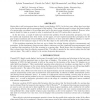Free Online Productivity Tools
i2Speak
i2Symbol
i2OCR
iTex2Img
iWeb2Print
iWeb2Shot
i2Type
iPdf2Split
iPdf2Merge
i2Bopomofo
i2Arabic
i2Style
i2Image
i2PDF
iLatex2Rtf
Sci2ools
HVEI
2009
2009
Psychophysical study of LCD motion-blur perception
Motion-blur is still an important issue on liquid crystal displays (LCD). In the last years, efforts have been done in the characterization and the measurement of this artifact. These methods permit to picture the blurred profile of a moving edge, according to the scrolling speed and to the gray-to-gray transition considered. However, other aspects should be taken in account in order to understand the way LCD motion-blur is perceived. In the last years, a couple of works have adressed the problem of LCD motion-blur perception, but only few speeds and transitions have been tested. In this paper, we have explored motion-blur perception over 20 gray-to-gray transitions and several scrolling speeds. Moreover, we have used three different displays, to explore the influence of the luminance range as well as the blur shape on the motion-blur perception. A blur matching experiment has been set up to obtain the relation between objective measurements and perception. In this experiment, observe...
Emerging Technology | Gray-to-gray Transitions | HVEI 2009 | LCD Motion-blur | Motion-blur Perception |
| Added | 18 Feb 2011 |
| Updated | 18 Feb 2011 |
| Type | Journal |
| Year | 2009 |
| Where | HVEI |
| Authors | Sylvain Tourancheau, Patrick Le Callet, Kjell Brunnström, Börje Andrén |
Comments (0)

